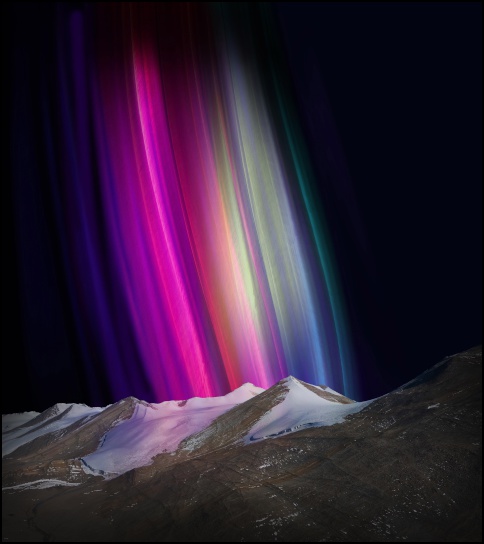Elusive Earth: Refined Images of Antarctica
Elusive Earth: Refined Images of Antarctica
10 November 2015 - 24 January 2016 Opening 9 November, 6pm at the Pah Homestead, TSB Bank Wallace Arts Centre
Elusive Earth: Refined Images of Antarctica features representations of Antarctica by seven contemporary New Zealand artists, who have travelled to the continent: Anne Noble, Phil Dadson, Megan Jenkinson, Joyce Campbell, Laurence Aberhart, Jae Hoon Lee and Joseph Michael (ordered by initial year of travel). Six of the artists travelled with assistance from Antarctica New Zealand - Antarctic Arts Fellows under the Artists to Antarctica Programme and the Invited Artists Programme. Joseph Michael is the most recent artist to Antarctica from this group. He travelled independently in early 2015 with his own support crew, and backing from various bodies including the Wallace Arts Trust.
Over several decades, artists practising in many different fields (painters, poets, jewellers, ceramicists, etc) have been inspired by their journeys to Antarctica. Peter McIntyre OBE is regarded as a ‘pioneer’ NZ artist to have travelled to the Southern Continent, in the late 1950s. Curatorial selection for Elusive Earth was made from work by a group of contemporary artists who have represented Antarctica in photography or video with sound. Medium is an underlining thread for this exhibition in one sense. However, depictions of Antarctica by this group show multiple ideas and concerns associated with the continent.
 Megan
Jenkinson, Atmospheric Optics XII, 2015, digital
inkjet print on Hahnemühle Photo Rag. Collection of the
Wallace Arts Trust.
Megan
Jenkinson, Atmospheric Optics XII, 2015, digital
inkjet print on Hahnemühle Photo Rag. Collection of the
Wallace Arts Trust.The Elusive Earth is Antarctica, its own particular ambiguities. Do we consider this continent as a place of legend or history, or more in regards to pertinent issues of the present? Historically, Antarctica is unique: full exploration occurred only in the 20th Century with some sightings and landings during the 18th and 19th centuries. The expeditions in the early 20th century have now become folklore: Ernest Shackleton, Roald Amundsen, and most notably R. Falcon Scott’s ill-fated journey of 1910-1912. It is one of the few places on earth with no indigenous peoples or inhabitants with close ancestral ties. The continent has its own distinctive political structure as a result of the Antarctic Treaty of 1961; a division in to territories administered by different nation states – not only is it owned by no single power, and where military exercises are forbidden, it is also only to be administered for the advancement of science. Could this be the vison of a political utopia, an apercu of an Enlightenment project? However the science yet returns something ominous: we can regard present-day Antarctica as being in a precarious state, a focal point for increasingly prevalent environmental concerns. It has a fragile ecosystem showing the effect of Climate Change and annual increases in tourism. The prospects are dim when we also consider our thirst for oil, with a requisite for new sites of exploration. The continent is placed in future doubt, but there is still much hope.
What does Antarctica mean to us? The artists in Elusive Earth do not provide clear answers but rather pose Antarctica as a point of enquiry. Their approach to the subject is disparate but collectively they can be regarded as artists-explorers – each mediating an experience of Antarctica. They have travelled and present samples, specimens, for engagement. These are refined, re-touched and re-treated visions, projections on the great white wall of abutting ice, a dream of something where the Earth itself remains elusive.
In her exhibition opening event Antarctic Shopping Party of 2008, Anne Noble presented the ice landscape as a commodity, something that is almost tangible: CDs, inflatable balls, puzzles, etc. Noble’s reference to present-day tourism recalls a long-held tradition - the appointment of artists to depict remote far-off lands in order to entice people to settle. A prime example in the early European settlement of New Zealand was Charles Heaphy (1820-1881) and the New Zealand Company. Heaphy’s scenes presented pre-Treaty era New Zealand in a very positive light, as readily hospitable; with no certain veracity.
ENDS


 PHARMAC: Pharmac Consulting On Six Medicines For New Zealanders
PHARMAC: Pharmac Consulting On Six Medicines For New Zealanders Athletics New Zealand: Funding Boost Propels Athletics NZ Toward LA 2028 Success
Athletics New Zealand: Funding Boost Propels Athletics NZ Toward LA 2028 Success Te Whatu Ora Health New Zealand: Large Numbers Of RSE Workers Get Immunised To Protect Pacific Island Nations
Te Whatu Ora Health New Zealand: Large Numbers Of RSE Workers Get Immunised To Protect Pacific Island Nations Eden Park: International Venue Of The Year And Ranked 25th In Pollstar’s Top 100 Worldwide Stadiums For Concerts
Eden Park: International Venue Of The Year And Ranked 25th In Pollstar’s Top 100 Worldwide Stadiums For Concerts Early Childhood New Zealand: Sector Responds To Regulatory Review Of Early Childhood Education (ECE)
Early Childhood New Zealand: Sector Responds To Regulatory Review Of Early Childhood Education (ECE)